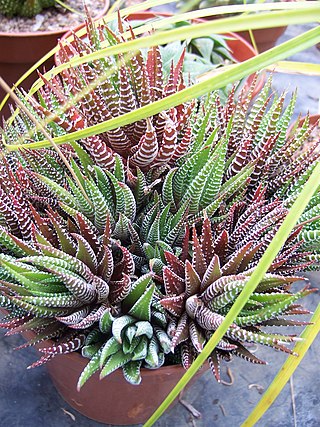
Gasteria is a genus of succulent plants, native to South Africa and the far south-west corner of Namibia.

Gasteria excelsa, or thicket gasteria, is a succulent plant native to the Eastern Cape Province, South Africa.

Haworthiopsis coarctata, formerly Haworthia coarctata, is a species of flowering succulent plant from the Eastern Cape Province, South Africa and naturalized in Mexico. It is one of the species of Haworthiopsis that is commonly cultivated as an ornamental.

Haworthia truncata, locally known as horse's teeth, is a species of succulent plant in the genus Haworthia. It is found in the Little Karoo region, in the far east of the Western Cape Province, South Africa.

Haworthia mirabilis is a species of the genus Haworthia belonging to the family Asphodelaceae.

Haworthiopsis attenuata, formerly Haworthia attenuata, commonly known as zebra haworthia, is a small species of succulent plant from the Eastern Cape Province, South Africa. As an ornamental, it is one of the most commonly cultivated of the Haworthiopsis species.

Gasteria acinacifolia, the dune gasteria, is succulent plant native to the Eastern Cape Province, South Africa.

Gasteria rawlinsonii is succulent plant of the genus Gasteria native to South Africa.

Gasteria disticha is succulent plant native to the Western Cape, South Africa.

Gasteria pillansii, the Namaqua gasteria, is succulent plant native to the arid winter-rainfall regions in the far west of South Africa and Namibia.

Gasteria bicolor is a species of succulent flowering plant in the family Asphodelaceae, native to the Eastern Cape, South Africa.

Gasteria nitida, the Bathurst gasteria, is a succulent plant, native to the Eastern Cape grasslands of South Africa.

Gasteria batesiana, or knoppies gasteria, is a species of succulent plant native to the inland escarpment in the far north-east of South Africa.

Gasteria carinata, commonly called Bredasdorp gasteria or keeled gasteria, is a small and variable succulent plant native to the Western Cape Province, South Africa.

Haworthiopsis scabra, formerly Haworthia scabra, is a species of flowering succulent plant from arid regions of the Western and Eastern Cape Provinces, South Africa.

Gasteria brachyphylla, the Klein Karoo gasteria, is succulent plant native to the Western Cape, South Africa.

Gasteria croucheri, or Natal gasteria, is a succulent plant native to KwaZulu-Natal Province, South Africa.

Gasteria baylissiana, or Suurberg gasteria, is a species of succulent flowering plant in the family Asphodelaceae native to the Eastern Cape, South Africa.

Gasteria glauca, the Kouga gasteria, is a succulent plant of the family Asphodelaceae native to the cliffs and rocky hillsides above the Kouga River, in the Eastern Cape, South Africa. It is most closely related to the species G. ellaphieae, G. vlokii and G. nitida. The flowers of all four species are also nearly identical, displaying the signature “gastric”, stomach-shaped blossoms that earn the genus the name of Gasteria. The blossoms are a favorite among pollinators, such as bees, lepidopterans, hoverflies, hummingbirds and sunbirds.

Gasteria polita, the polished gasteria, is a recently discovered succulent plant restricted to a locality in the Afro-temperate forest of the Western Cape, South Africa.




















